ERP Readiness Series: People – 5 Things Every Executive Sponsor Must Do
This is the second in a series on Enterprise Resource Planning (ERP) Readiness. Last time we looked at the seven roles you’ll need on your team to successfully implement a new ERP system or upgrade an existing one. In this post we look more closely at the first role, that of the Executive Sponsor.
Executive Sponsor Responsibilities
When we say Executive Sponsor, we’re referring the owner or founder of a smaller company, or their delegate—perhaps the accounting professional in this context. For a medium-sized company, this will typically be the CFO or the senior accounting leadership. For larger companies, this may still be the CFO and may also be the CIO or other Senior IT leadership. Let’s talk about the Executive Sponsor’s responsibilities.
- It is the Executive Sponsor’s responsibility to provide support, encouragement, and to convey a message of full support from the executive team. This may look different in differently-sized companies as executive teams differ in size and make up. But, what is universally true is that the job of an effective Executive Sponsor is to be the bridge between the Implementers or “Core Team” and the executive leadership of the company. The importance of this role cannot be understated. A tone of positivity and support must flow from the leadership of the company to the team responsible for implementing the ERP solution. Executive Sponsors are not only cheerleaders, they are roadblock removers and issue resolvers.
- The Executive Sponsor needs to participate in, if not lead, the steering committee meetings. Most successful ERP implementations involve a steering committee, comprised of the Executive Sponsor, the Project Managers, and even members of the Core Team as needed. Occasionally, Steering Committees will include other members of the executive team as well.
- Project milestones will be tracked during Steering Committee meetings, and it is the job of the Executive Sponsor to hold the Core Team accountable for milestones. Note that this does not mean that the Executive Sponsor is going to be involved in day-to-day details, but he or she does need to have a clear view of the how overall progress is being made. It is also the job of the Executive Sponsor to communicate progress back to the executive team.
- Executive Sponsors must also be informed of identified risks and accompanying action plans because the Steering Committee and Core Team must rely on the Executive Sponsor to make corporate-level decisions to propel the project forward. When the Steering Committee or Core Team gets stuck or encounters challenges, the Executive Sponsor is kept abreast of the situation.
- The Executive Sponsor is kept abreast of the situation so that he or she can make informed decisions. Ultimately, corporate-level decisions are for the Executive Sponsor to make. Stated differently, it is the job of the Executive Sponsor to resolve project-related issues that can only be solved at the corporate level.
Unlike many of the other roles we will discuss in this series, the Executive Sponsor is exclusively an in-house role since the Executive Sponsor is an owner, founder, or C-Suite level executive.
Are you an executive who is considering changing or upgrading your ERP solution? Do you have questions regarding the role of an Executive Sponsor? Don’t hesitate to contact us.
—
Photo Credit:
ERP Readiness Self-Assessment
Is your organization ready for a new or upgraded ERP solution? Find out with this complimentary self-assessment.
Doing Business Better
You strive for excellence, believe in your people, and want to do things right the first time. And you know that you need help to get to the heart of your business challenges and make the best choices for the future of your privately held manufacturing and distribution company. That’s where we come in.
We help you focus and find exactly the right path to accelerated growth and sustainable success — from your people to your processes to your ERP software.



